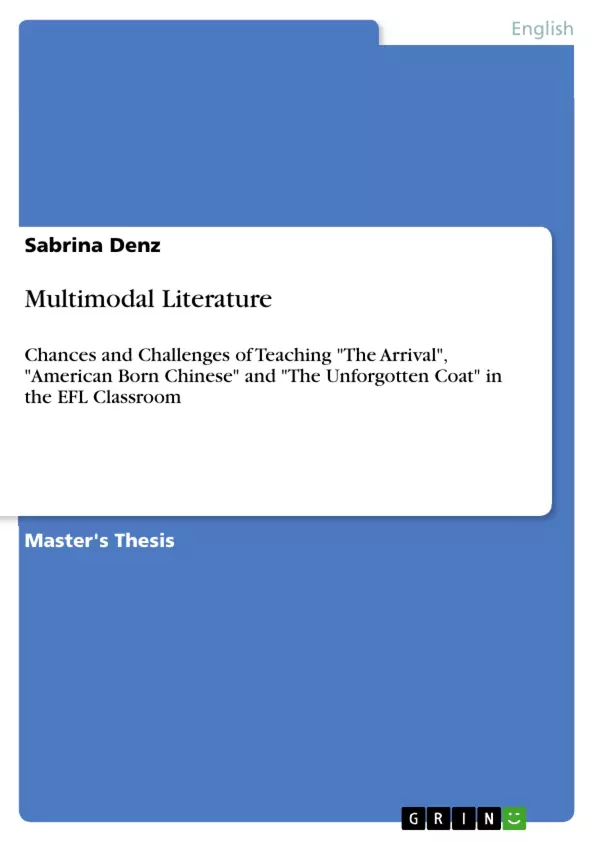The aim of this paper is to demonstrate that implementing a pedagogy of multiliteracies and multimodal literature can have a great impact on teaching in the EFL classroom. In the last chapter, three different multimodal novels will therefore be highlighted. An analysis will take place on how Shaun Tan’s "The Arrival", Gene Luen Yang’s "American Born Chinese" and Frank Cottrell Boyce’s "The Unforgotten Coat" can foster a multimodal literacy. For this purpose, possible ways of teaching will be drafted.
At the beginning of this decade we started to face a new world-wide crisis. Due to the current global pandemic many economic, political and social changes arise for everyone. Even if we cannot predefine the impacts of this transition in the long run, we can assume that it will effectuate changes for the working and social life of many people around the globe. In fact, this situation already requires new methods for learning, working and socializing on different levels. In times of globalization and mass migration, diversity and heterogeneity became natural phenomena. Besides, (foreign) languages and English as a lingua franca became more important for everyday life. It led to the implementation of new technologies, and especially new communication systems, which are frequently used world-wide. Communication apps like WhatsApp or Instagram, which are used by the majority of young people nowadays, are an integral part of social life. Today, the necessity for using these in learning environments is stronger than ever. With it comes the demand to use these communication systems appropriately. The influences of digital technologies also set new needs for learning and teaching in the English foreign language classroom. The crisis, yet again, underlines the demands for new learning methods, which have long been discussed in schools and other educational settings.
Inhaltsverzeichnis (Table of Contents)
- Introduction
- State of Research
- Defining Literacy
- Multimodal Literacy
- The Concept of Multiliteracies
- Multimodal Literature
- Comics
- Graphic Novels
- Teaching Multimodal Literature in the EFL Classroom
- Teaching Literature
- Challenges of Teaching Multimodal Literature
- Multimodal Literature in the EFL Classroom
- Teaching Multimodal Literature
- Choosing Multimodal Literature
- Approaching Multimodal Literature
- Shaun Tan's The Arrival
- Gene Luen Yang's American Born Chinese
- Frank Cottrell Boyce's The Unforgotten Coat
Zielsetzung und Themenschwerpunkte (Objectives and Key Themes)
The aim of this thesis is to emphasize the importance of multimodal approaches in literary learning within the EFL classroom. It explores the current state of research on literacy, multimodal literacy, and multiliteracies, highlighting the argumentations of Lankshear & Knobel, Bezemer & Kress, and the New London Group. The paper delves into the pedagogical implications of these theories, particularly in relation to multimodal literature, focusing on comics and graphic novels. It analyzes three specific multimodal novels - Shaun Tan's The Arrival, Gene Luen Yang's American Born Chinese, and Frank Cottrell Boyce's The Unforgotten Coat - to demonstrate how they can foster a multimodal literacy.
- The importance of multimodal approaches in literary learning.
- The evolution of literacy concepts, including multimodal literacy and multiliteracies.
- The pedagogical implications of these theories for EFL teaching.
- The role of multimodal literature, particularly comics and graphic novels, in fostering multimodal literacy.
- The analysis of specific multimodal novels to illustrate their potential in EFL classrooms.
Zusammenfassung der Kapitel (Chapter Summaries)
The introduction emphasizes the growing significance of multimodal and multimedial communication in a globalized world, particularly in the EFL classroom. The paper argues for the need to integrate new learning methods that acknowledge the changing nature of meaning-making processes in a digitally driven era. The chapter outlines the importance of multimodal literacy and its potential for fostering active citizenship. The research focuses on multimodal novels, graphic novels, and comics as potential learning objects.
The second chapter delves into the current state of research on literacy. It examines the evolution of the term literacy, highlighting its connection to both education and economic readiness. The chapter discusses the role of multimodal literacy in promoting diverse language use and engaging with the meaning-making process in various contexts.
The third chapter explores the challenges and opportunities of teaching multimodal literature in the EFL classroom. It discusses the traditional approaches to teaching literature and the need to adapt pedagogical methods to incorporate the multimodal nature of contemporary texts. The chapter examines the potential of multimodal literature to enhance student motivation and engage them in the meaning-making process.
The fourth chapter focuses on the practical aspects of teaching multimodal literature. It provides guidance on choosing appropriate texts and outlines effective approaches to teaching multimodal novels. The chapter then delves into the analysis of three specific works: Shaun Tan's The Arrival, Gene Luen Yang's American Born Chinese, and Frank Cottrell Boyce's The Unforgotten Coat. It explores how these novels can contribute to the development of multimodal literacy in the EFL classroom.
Schlüsselwörter (Keywords)
The main keywords and focus topics of this thesis are: multimodal literature, multimodal literacy, multiliteracies, EFL classroom, graphic novels, comics, meaning-making, digital literacy, active citizenship, teaching methods, and learner motivation. These terms highlight the key concepts and themes explored in the research, including the evolving nature of literacy, the importance of multimodality in contemporary communication, and the potential of multimodal literature to enhance language learning and foster critical engagement with the world.
- Quote paper
- Sabrina Denz (Author), 2020, Multimodal Literature, Munich, GRIN Verlag, https://www.grin.com/document/1166636



